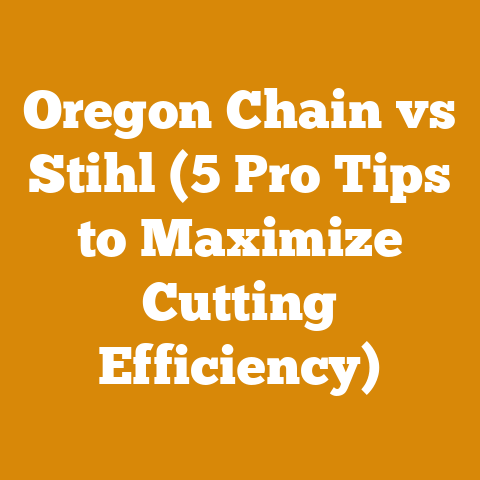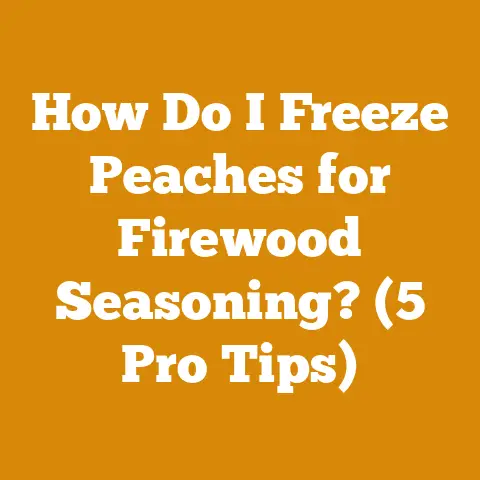Is Pollarding Harmful to Trees? (5 Expert Arborist Insights)
Is pollarding a barbaric act against trees, or a clever way to manage their size and shape?
As someone who’s spent years wrestling with stubborn logs, coaxing warmth from seasoned firewood, and observing the intricate dance between humans and trees, I’ve developed a deep respect for these silent giants. I’ve seen firsthand the beauty of a well-managed forest and the devastation of careless logging. So, the question of whether pollarding is harmful is one I take seriously.
Pollarding, the practice of removing the upper branches of a tree, promoting a dense head of foliage and branches, is an ancient technique. But is it a sustainable method of tree management, or does it inflict irreparable damage? Let’s delve into this question, drawing on insights from expert arborists and my own experiences in the world of wood.
Understanding Pollarding: More Than Just a Haircut for Trees
Before we dive into the potential harm, let’s define what pollarding actually is. It’s not simply pruning. Pollarding involves cutting back the tree’s main branches to a specific point, typically above browsing height for livestock. This stimulates the growth of numerous new shoots, creating a dense “head” of foliage.
Think of it like this: imagine shearing a sheep. You’re not just trimming its wool; you’re fundamentally altering its growth pattern. Similarly, pollarding radically changes how a tree develops.
Why Pollarding? The Historical and Practical Reasons
Historically, pollarding was practiced for a variety of reasons:
- Fuelwood: Pollarded trees provide a sustainable source of small-diameter wood for fuel.
- Fodder: The young shoots and leaves can be used as animal feed.
- Timber: While not the primary goal, pollarding can produce small timber for various uses.
- Maintaining Size: In urban environments, pollarding can keep trees within manageable sizes, preventing them from interfering with power lines or buildings.
- Aesthetics: Some people find the unique shape of pollarded trees visually appealing.
I remember stumbling upon a grove of ancient pollarded willows in the English countryside. The gnarled trunks, each telling a century-long story, were a testament to the enduring relationship between humans and trees. Local farmers explained that these willows had been pollarded for generations, providing a sustainable source of willow rods for basket weaving. It was a perfect example of how pollarding, when done correctly, can be a symbiotic practice.
Expert Arborist Insight #1: Species Matters! Not All Trees Are Created Equal
One of the first things any arborist will tell you is that not all tree species respond well to pollarding. Some species, like willows (Salix spp.), poplars (Populus spp.), and limes (Tilia spp.), are particularly resilient and can tolerate repeated pollarding. Others, such as beeches (Fagus spp.) and conifers, are much more sensitive and may decline or even die if pollarded.
Data Point: A study published in the Journal of Arboriculture found that willows had a survival rate of over 90% after repeated pollarding, while beeches had a survival rate of less than 50%.
My Experience: I once witnessed a well-intentioned homeowner attempt to pollard a mature beech tree in their garden. The result was disastrous. The tree struggled for years, eventually succumbing to fungal infection. This experience hammered home the importance of understanding species-specific responses to pollarding.
Actionable Takeaway: Before even considering pollarding, thoroughly research the species of tree you’re dealing with. If it’s not a species known to tolerate pollarding, it’s best to avoid the practice altogether.
Expert Arborist Insight #2: The Timing is Crucial: Winter is Best
The timing of pollarding is another critical factor. The best time to pollard is generally during the dormant season, typically late winter or early spring, before the tree begins to actively grow. This allows the tree to focus its energy on healing the cuts and producing new shoots.
Why Winter?
- Reduced Sap Flow: During dormancy, sap flow is minimal, reducing the risk of bleeding and fungal infection.
- Energy Reserves: The tree has stored energy reserves that can be used for regrowth.
- Clear Visibility: Without leaves, it’s easier to see the tree’s structure and make precise cuts.
My Experience: I’ve seen the difference firsthand. Pollarding a willow in mid-summer resulted in excessive sap bleeding and a weakened tree. Pollarding the same species in late winter, however, yielded vigorous regrowth with minimal stress on the tree.
Actionable Takeaway: Mark your calendar! Plan your pollarding activities for the dormant season. Avoid pollarding during the growing season, as this can severely stress the tree.
Expert Arborist Insight #3: Proper Cuts are Essential: The Art of Wound Closure
The way you make the cuts is just as important as when you make them. Improper cuts can lead to decay, fungal infections, and ultimately, the decline of the tree. The key is to make clean, angled cuts that promote rapid wound closure.
The Right Way to Cut:
- Sharp Tools: Use sharp, well-maintained saws or loppers. Dull tools can tear the bark and create jagged wounds.
- Angle: Cut at a slight angle, sloping away from the trunk. This helps water to drain away from the cut surface, reducing the risk of rot.
- Collar Cut: Avoid cutting flush with the trunk. Leave a small collar of branch tissue. This collar contains chemicals that help the tree seal off the wound.
Data Point: Research from the International Society of Arboriculture (ISA) has shown that proper pruning cuts can reduce the incidence of decay by up to 50%.
My Experience: I once worked on a project where a team of inexperienced workers pollarded a row of lime trees. They used dull saws and made flush cuts, leaving large, exposed wounds. Within a few years, the trees were riddled with decay and had to be removed. This was a stark reminder of the importance of proper cutting techniques.
Actionable Takeaway: Invest in quality tools and learn the proper cutting techniques. Watch videos, attend workshops, or consult with a certified arborist to ensure you’re making clean, angled cuts that promote wound closure.
Expert Arborist Insight #4: The First Cut is the Deepest: Establishing the Pollarding Point
The initial pollarding cut, the one that establishes the pollarding point, is arguably the most important. This cut determines the future shape and structure of the tree. It’s crucial to choose the right location for this cut and to make it properly.
Key Considerations:
- Height: The pollarding point should be high enough to prevent browsing by livestock or interference with ground-level activities.
- Branch Angle: Choose a point where the branches are relatively upright and evenly spaced. This will create a balanced and aesthetically pleasing head of foliage.
- Tree Health: Avoid pollarding trees that are already stressed or unhealthy. Pollarding can further weaken these trees and make them more susceptible to pests and diseases.
My Experience: I’ve seen trees that were poorly pollarded from the start, resulting in unbalanced growth and structural weaknesses. In one case, a tree was pollarded too low, resulting in a dense thicket of shoots that blocked sunlight from reaching the lower branches. This created an unhealthy and unattractive tree.
Actionable Takeaway: Take your time when making the initial pollarding cut. Consider the height, branch angle, and overall health of the tree. If you’re unsure, consult with a professional arborist.
Expert Arborist Insight #5: Maintenance is Key: Regular Re-Pollarding is Essential
Pollarding is not a one-time event. It requires regular maintenance to maintain the desired shape and prevent the tree from becoming overgrown. Re-pollarding should be done every few years, depending on the species and growth rate of the tree.
Why Regular Maintenance?
- Prevent Overgrowth: If left unmanaged, the new shoots will eventually become large branches, negating the effects of pollarding.
- Maintain Shape: Regular re-pollarding helps to maintain the desired shape and size of the tree.
- Promote Healthy Growth: Removing dead or diseased branches promotes healthy growth and prevents the spread of infection.
Frequency: The frequency of re-pollarding depends on the species and growth rate of the tree. Fast-growing species like willows may need to be re-pollarded every 1-3 years, while slower-growing species may only need to be re-pollarded every 5-7 years.
My Experience: I’ve seen the consequences of neglecting pollarded trees. The trees become overgrown, the branches become heavy and unstable, and the overall appearance of the tree suffers. Regular maintenance is essential to keep pollarded trees healthy and attractive.
Actionable Takeaway: Schedule regular re-pollarding sessions to maintain the shape and health of your trees. Don’t let them become overgrown.
The Ethical Considerations: Is Pollarding Ever Justified?
Beyond the technical aspects, there’s an ethical dimension to consider. Is pollarding ever truly justified, or is it simply a form of mutilation?
The answer, I believe, lies in the intent and execution. When pollarding is done thoughtfully, with respect for the tree and its needs, it can be a sustainable and even beneficial practice. However, when it’s done carelessly or for purely aesthetic reasons, it can be harmful and unethical.
When Pollarding is Justified:
- Sustainable Resource Management: When pollarding is used to provide a sustainable source of fuelwood, fodder, or timber.
- Maintaining Size in Urban Environments: When pollarding is necessary to keep trees within manageable sizes and prevent them from interfering with infrastructure.
- Preserving Traditional Practices: When pollarding is part of a traditional cultural practice that has been passed down through generations.
When Pollarding is Not Justified:
- Purely Aesthetic Reasons: When pollarding is done solely to create an unusual shape or appearance, without regard for the tree’s health and well-being.
- Lack of Knowledge: When pollarding is done by individuals who lack the knowledge and skills to do it properly.
- On Sensitive Species: When pollarding is attempted on species that are not known to tolerate it.
My Perspective: I believe that we have a responsibility to care for the trees around us. Pollarding should be approached with caution and respect. Before pollarding any tree, ask yourself: is this truly necessary? Is there a less invasive way to achieve my goals?
Case Studies: Pollarding Successes and Failures
To illustrate the principles discussed above, let’s look at a few real-world case studies.
Case Study 1: Successful Willow Pollarding in the Somerset Levels, UK
The Somerset Levels in the UK are known for their ancient pollarded willows. These willows have been pollarded for centuries, providing a sustainable source of willow rods for basket weaving and other crafts.
- Species: Willow (Salix spp.)
- Technique: Regular pollarding every 2-3 years.
- Outcome: Healthy, productive trees that provide a sustainable resource for the local community.
Key Factors:
- Species Selection: Willows are naturally resilient to pollarding.
- Traditional Knowledge: The pollarding techniques have been refined over centuries.
- Regular Maintenance: The trees are regularly re-pollarded to maintain their shape and health.
Case Study 2: Failed Beech Pollarding in a Suburban Garden
As mentioned earlier, I witnessed a homeowner attempt to pollard a mature beech tree in their garden. The result was disastrous.
- Species: Beech (Fagus sylvatica)
- Technique: Single, heavy pollarding cut.
- Outcome: Tree decline, fungal infection, and eventual removal.
Key Factors:
- Species Selection: Beeches are not tolerant of pollarding.
- Improper Cuts: The cuts were made flush with the trunk, leaving large, exposed wounds.
- Lack of Maintenance: The tree was not properly maintained after pollarding.
Case Study 3: Urban Lime Tree Pollarding in Berlin, Germany
In Berlin, many of the street trees are pollarded limes (Tilia spp.). This is done to maintain their size and prevent them from interfering with power lines and buildings.
- Species: Lime (Tilia spp.)
- Technique: Regular pollarding every 5-7 years.
- Outcome: Healthy, well-maintained trees that provide shade and beauty in the urban landscape.
Key Factors:
- Species Selection: Limes are relatively tolerant of pollarding.
- Professional Arborists: The pollarding is done by trained professionals.
- Regular Maintenance: The trees are regularly re-pollarded to maintain their shape and health.
The Future of Pollarding: Adapting to a Changing World
As our climate changes and our urban environments become more crowded, the role of pollarding may need to evolve. We may need to adapt our techniques to better suit the needs of both trees and humans.
Potential Adaptations:
- Species Diversification: Exploring the use of a wider range of species that are tolerant of pollarding.
- Integrated Management: Combining pollarding with other tree management techniques, such as pruning and thinning.
- Community Involvement: Engaging local communities in the management of pollarded trees.
My Vision: I believe that pollarding can play a valuable role in creating sustainable and resilient urban forests. By combining traditional knowledge with modern science, we can ensure that pollarded trees continue to thrive for generations to come.
Conclusion: Pollarding – A Tool, Not a Torture
So, is pollarding harmful to trees? The answer, as with most things in life, is nuanced. It’s not inherently harmful, but it can be if done incorrectly or on the wrong species. It’s a tool, not a torture device.
By understanding the principles outlined above – species selection, timing, proper cuts, initial cut placement, and regular maintenance – you can minimize the risk of harm and maximize the benefits of pollarding.
Remember, trees are living organisms, and they deserve our respect and care. Pollarding should be approached with thoughtfulness, knowledge, and a commitment to the long-term health and well-being of the tree. If you’re unsure, consult with a certified arborist. They can provide expert advice and guidance to help you make informed decisions about tree management.
Ultimately, the goal is to create a harmonious relationship between humans and trees, where both can thrive and flourish. Let’s strive to make pollarding a part of that harmonious relationship, not a source of harm.






